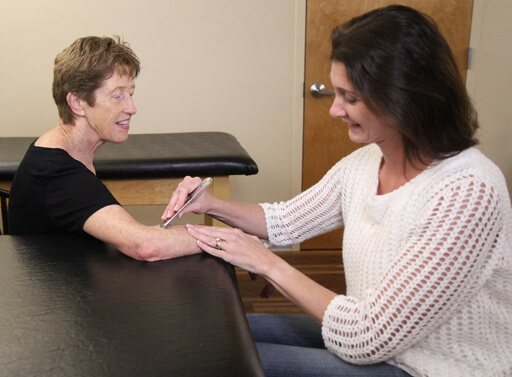Graston®
 The Graston Technique is a form of manual therapy that uses specialized and unique handheld instruments to mobilize the soft tissue. This type of therapy is designed to help your therapist identify and treat areas of soft tissue restriction and scar tissue. The Graston Technique is often practiced by Physical Therapists as well as Chiropractors, Osteopathic Physicians, Occupational Therapists and some Massage Therapists.
The Graston Technique is a form of manual therapy that uses specialized and unique handheld instruments to mobilize the soft tissue. This type of therapy is designed to help your therapist identify and treat areas of soft tissue restriction and scar tissue. The Graston Technique is often practiced by Physical Therapists as well as Chiropractors, Osteopathic Physicians, Occupational Therapists and some Massage Therapists.
Graston Technique Goals:
The general goal of this type of therapy is to reduce pain and increase function. This can often be accomplished by:
• Breaking down the scar tissue and fascia restrictions that are usually associated with some form of trauma to the soft tissue. The trauma can be from a strained muscle, tendon or fascia or a ligament sprain.
• Reducing restrictions by stretching connective tissue in an attempt to rearrange the structures of the soft tissue.
• Promoting a better healing environment for the injured tissue by reducing inflammation and promoting healthy blood flow to the area.
• Activating the body’s position sense organs, such as mechanoreceptors and proprioceptors when certain nerve fibers are activated with this manual technique.
The Graston Technique Tools:
There are 6 core tools used in Graston Technique. These tools are made of stainless steel and are designed in a convex or concave shape. They all have rounded edges and are not sharp. The instruments are used to scan over and detect areas of injured tissue. These same tools are used with specific techniques to treat the injured tissue as needed. This process is designed to both identify the injured areas and provide treatment to the soft tissue.
Graston Technique Treatment:
Using cross-friction massage which involves brushing or rubbing against the grain of the scar tissue, the therapist will mobilize the soft tissue in the affected area. In some cases, the process temporarily causes inflammation. This increases the amount of blood flow in and around the area. The theory is that this process helps initiate and promote the healing process of the affected soft tissue.
Treatment may occur in other areas of the body that may seem remote, but are connected. For example, a patient presenting with hip pain may also receive treatment to the lower back, glutes or hamstrings.
Treatment time is usually 30- 60 seconds per area treated, with a total of about 10 minutes. It is common for patients to experience some discomfort during the procedure due to the soft tissue tightness.
When an injury within the soft tissue occurs, the tissue repairs itself in a haphazard pattern forming scar tissue. While the scar tissue itself is not painful, it does tend to limit the range of motion and any ongoing stiffness may contribute to chronic pain. The Graston technique has the potential to treat acute and chronic conditions such as:
-
Lower back strain or sprain
-
Achilles tendinitis
-
Plantar fasciitis
-
Rotator cuff tendinitis
-
Biceps tendinitis
-
Shin splints
-
Tennis elbow
-
Golfers elbow
-
Patella tendinitis
-
ITB syndrome


